Raydium (RAY) Explained: DEX, AMM & LaunchLab
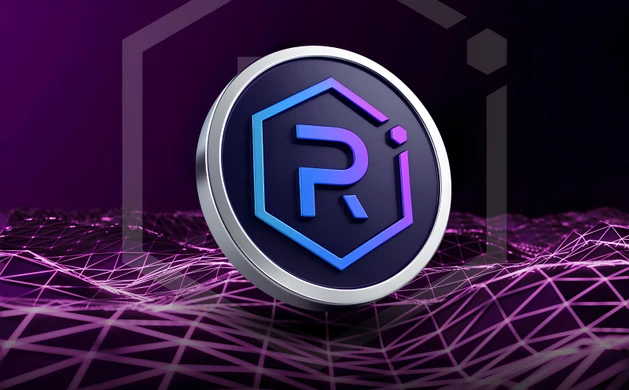
Summary: Raydium is a leading decentralized exchange (DEX) on Solana, combining swaps through Automated Market Making (AMM), yield farming, and LaunchLab meme token launches.
As of 2025, the protocol holds over $2 billion in Total Value Locked (TVL), processes about $32.3 billion in monthly volume, and its governance RAY token has a market capitalization of $950 million.
Raydium remains Solana’s most versatile DEX, now offering V4 concentrated liquidity and access to 8,000+ markets, spanning from blue chips like SOL, WETH, WBTC, to meme coins like TRUMP and WIF.
Supported Blockchains
Just Solana, with over $2B in total value locked across 2,900 pools
Fees
0.25% on swaps, 0%/0.025% maker/take on perpetuals
Aditional Features
LaunchLab token generator for creating & trading meme coins
What is Raydium?
Raydium is a Solana decentralized exchange featuring instant token swaps with advanced tools for liquidity providing, futures trading, and token launching. Liquidity comes from onchain order books, matching trades between buyers and sellers, and AMM pools, using algorithms to price and execute instantly.
The platform was founded in February 2021 by a pseudonymous team, gaining popularity for pairing AMM accessibility with liquidity from other DEXs. After FTX collapsed, Raydium adapted to OpenBook, a community-run order book, and later released the V3 and V4 upgrades with more efficient pools and adjustable fees.
Joining Raydium requires a Solana-compatible wallet such as Phantom or Solflare, plus enough SOL to cover transaction costs. You can fund it from a centralized exchange, purchase directly through Raydium (KYC needed), or bridge assets from other blockchains.
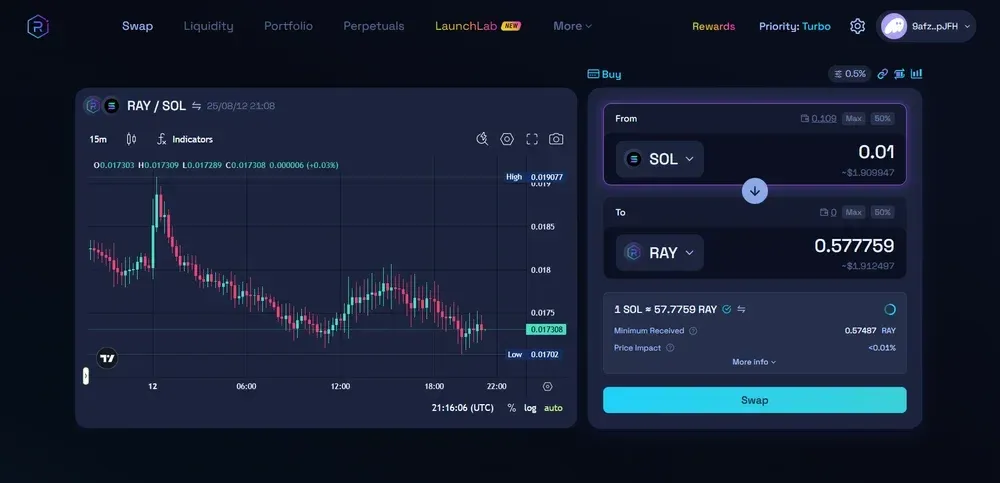
How Does Raydium Work?
Raydium lets you trade on Solana using either a quick swap interface or a full order-book trading view. Behind the scenes, its engine sources liquidity from both internal pools and external markets.
Here is how Raydium works in detail:
- Swap Interface: A beginner-friendly page for instantly exchanging one SPL token for another, with “Best Price Swaps” automatically routing trades for optimal outcomes.
- Trade Interface: An advanced order-book view with charts, market depth, and the ability to set limit orders for supported pairs.
- Liquidity Pools: User-funded token reserves called liquidity pools that power swaps; providers earn a share of trading fees proportional to their pool share.
- Yield Farming: Optional staking of LP tokens in “Farms” to earn extra rewards on top of regular liquidity-provider fees.
- Staking RAY: Locking Raydium’s native token to earn protocol rewards and potentially qualify for token sale allocations on its launchpad.
- Perpetual Futures: Leveraged trading via an onchain central limit order book, allowing speculation on price movements without owning the underlying asset.
- Blinks & Referrals: Shareable links that trigger swaps directly in wallets or on social platforms, earning a percentage of referred trade volume fees.

How to Use Raydium
Raydium gives traders and liquidity providers direct access to Solana's decentralized finance, featuring over 8,000 market pairs, multiple pool types, and onchain perpetual futures with decently high leverage. Every feature is accessible from its web app with only a connected Solana Program Library (SPL) wallet.
1. Swap tokens instantly with Raydium’s trading interface
The Swap tab executes fast AMM trades using Best Price Swaps, routing between Raydium’s own pools and OpenBook’s order book, with trades typically completing in two to four seconds. Advanced traders can use the Trade tab for live order books, charts, and limit order placement.
How to swap on Raydium:
- Connect your Solana wallet and select the Swap tab.
- Choose the token you’re paying with and the token you want to receive.
- Enter the amount to swap and review “Minimum Received” and price impact.
- Click Swap, approve the transaction, and wait for confirmation in seconds.
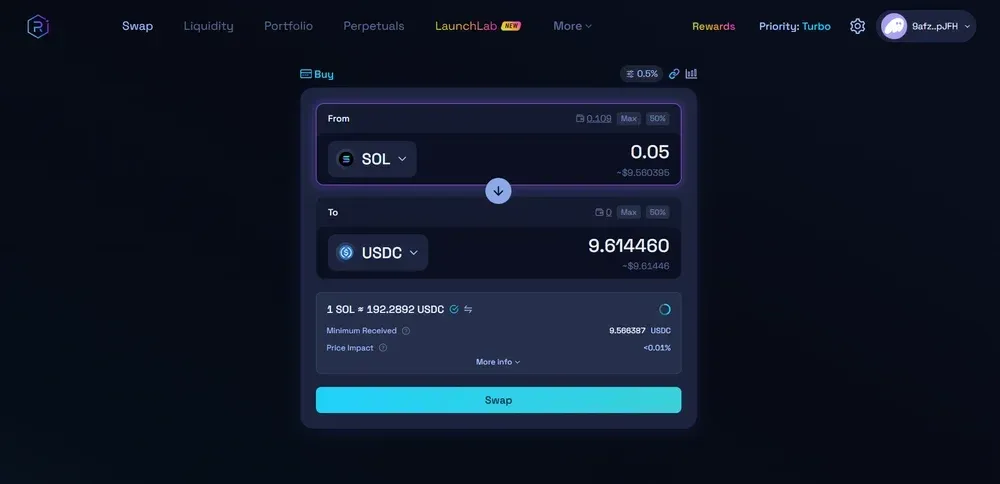
2. Add liquidity to pools for fee and reward earnings
By depositing equal-value pairs of tokens, you earn 88% of the 0.25% swap fee, with APYs often between 20% and 40%. Raydium offers Concentrated Liquidity Pools (CLMM) for targeted ranges and Constant Product Pools (CPMM) for full-range market making, plus Farms for extra RAY rewards.
How to add liquidity using Raydium:
- Connect your wallet and open the Liquidity page.
- Select a pool or search by token/pool address.
- For CLMM, set a price range; for constant product pools, proceed directly to deposit.
- Enter token amounts matching the required ratio and confirm the transaction.
- Optionally, stake LP tokens in a Farm for extra rewards.
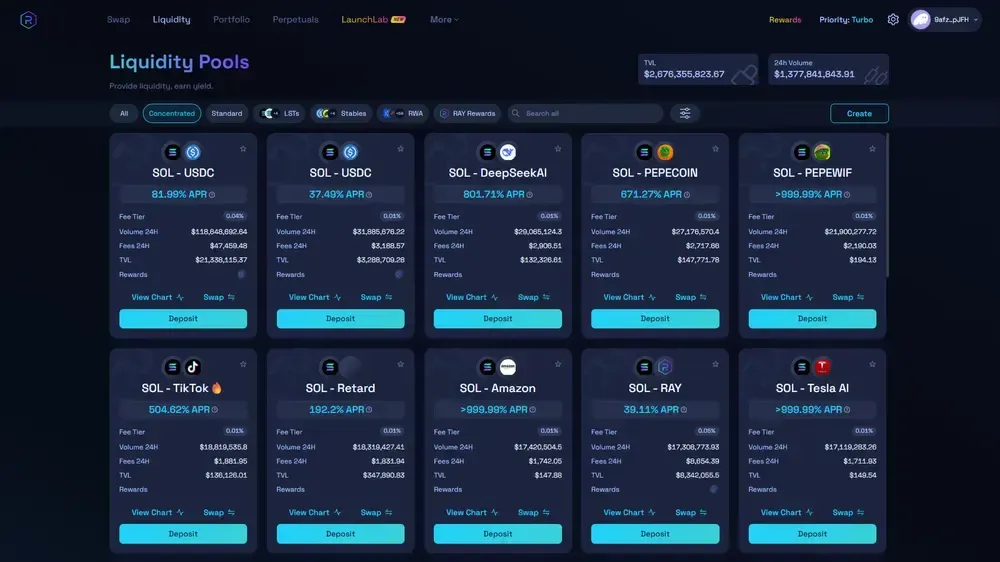
3. Launch custom pools for tokens not yet available
Raydium’s permissionless pool creation lets anyone list a new SPL token by depositing initial liquidity. This was central to the 2024-2025 meme coin surge, especially through Pump.fun integrations that automated pool creation (feature now replaced by Raydium's LaunchLab token generator).
How to launch a liquidity pool on Raydium:
- Connect your wallet and go to the Create Pool section.
- Enter the token mint addresses for both sides of the pair.
- Deposit initial liquidity in equal USD value.
- Confirm the transaction to make the pair tradable immediately.
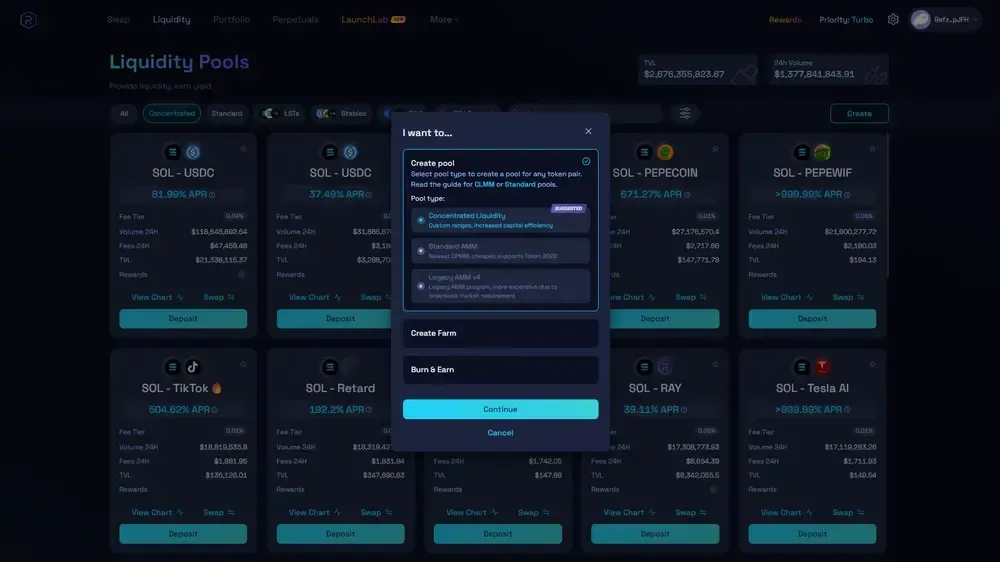
4. Trade perpetual futures using leverage for higher exposure
Raydium Perps supports up to 50x leverage, collateralized in USDC, operating in cross-margin mode so collateral is shared across positions. Built on an onchain central limit order book, it offers CEX-grade order types and layouts while keeping your funds in your wallet.
How to trade Raydium perpetuals:
- Navigate to Perpetuals and connect your wallet.
- Register and generate an API key if prompted.
- Deposit USDC as collateral.
- Select a trading pair, set leverage, and choose market, limit, or stop order.
- Place the order and monitor your position in the account panel.

Raydium's LaunchLab Explained
Raydium’s LaunchLab is a memecoin and micro-cap token launchpad introduced in April 2025 to capture the growing meme market. It lets creators launch tokens for free using customizable bonding curves, automatically migrating successful launches to full Raydium AMM pools.
The launchpad was a response to Pump.fun ending its integration with Raydium and moving all token launches to its own PumpSwap DEX in March 2025. Since going live, LaunchLab has hosted 900,000+ token launches, with roughly 1% meeting the 85 SOL graduation threshold to become permanent Raydium AMM pools.

How to Create Meme Coins on LaunchLab
LaunchLab supports two modes: JustSendit for quick, no-configuration launches, and LaunchLab Mode for full control over tokenomics and curve parameters. Once the bonding curve rises at least 85 SOL, liquidity migrates automatically to a Raydium AMM pool, with LP tokens burned to secure liquidity.
Here is how to use LaunchLab:
- Open LaunchLab tab and choose mode: Select JustSendit for defaults or LaunchLab for custom supply, curve, and vesting options.
- Enter token details: Fill in name, ticker, optional description, and image (128 x 128 pixels preferably); add social links for discoverability.
- Sign wallet and create token: Confirm wallet ownership, finalize creation, and optionally place an initial buy to deter snipers and other crypto trading bot users.
- Configure advanced settings (LaunchLab Mode): Set SOL raise target (min 30), bonding curve % supply, and optional vesting with cliff/duration.
- Enable Creator Fee Share if desired: Earn 10% of LP trading fees post-migration via Raydium’s Burn & Earn system.
- Launch and share your token: Use the “Share” button to generate referral links and earn 0.1% of referred trades in SOL.
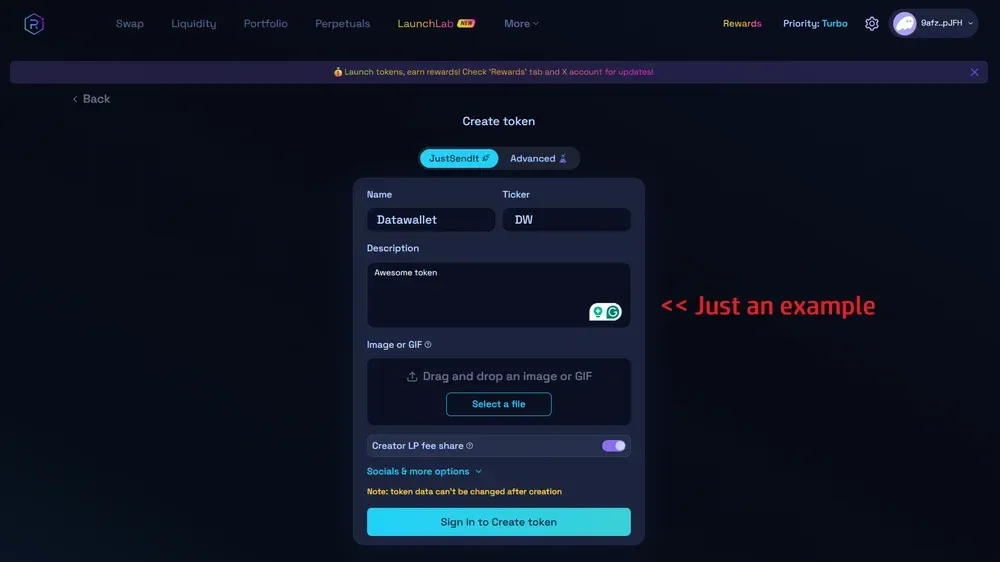
Raydium Fees
Raydium uses a mix of swap, AMM, CLMM, and perpetual trading fee structures. Fees often contribute to liquidity provider rewards, RAY token buybacks, and treasury funding, depending on the pool type.
Below is a breakdown of all fees that you might encounter using Raydium:
- Perpetuals: 0% maker fee, 0.025% taker fee via Orderly Network, plus 1 USDC flat withdrawal fee.
- Standard Swaps: 0.25% fee; 0.22% to LPs and 0.03% to RAY buybacks on every trade executed.
- Swap Fee Tiers: 0.01%, 0.05%, 0.25%, or 1%, chosen by pool creators based on asset volatility and trading volume.
- AMM v4 Pools: Fixed 0.25% fee; 84% to LPs, 12% to RAY buybacks, 4% to the treasury.
- CPMM Pools: Fee tiers of 4%, 2%, 1%, or 0.25% with the same 84/12/4% distribution split.
- CLMM Pools: Eight fee tiers from 2% down to 0.01%, also using the 84/12/4% revenue distribution.
- LaunchLab Tokens: 1% fee on trades post-migration; 25% for RAY buybacks and 10% to the creator.
- Network Fees: Most trades cost 0.0001-0.001 SOL in Solana network fees.
- Position Creation Costs (one-time): 0.00245688 SOL for protocol position, 0.00284664 SOL for account creation, and 0.00484416 SOL for NFT mint + ATA.
- Other Fees: Priority fees are negligible (<0.000007 SOL) but may apply for faster confirmation.
RAY Tokenomics
RAY is Raydium’s native utility and governance token, used for staking, earning a share of platform fees, and participating in exclusive token launches. It has a fixed supply of 555 million tokens, with allocations designed to incentivize liquidity, growth, and long-term platform alignment.
RAY's tokenomics look as follows:
- Mining Reserve: 34% (188.7M RAY) for liquidity mining, emitting ~1.9M RAY annually to incentivize platform participation.
- Partnership & Ecosystem: 30% (166.5M RAY) dedicated to integrations, strategic partnerships, and ecosystem development initiatives.
- Team (Vested): 20% (111M RAY) fully locked for 12 months post-TGE, then linearly unlocked over the next 24 months.
- Liquidity: 8% (44.4M RAY) allocated to market liquidity to ensure smooth trading and minimal slippage for users.
- Community & Seed (Vested): 6% (33.3M RAY) locked for 12 months post-TGE, then linearly unlocked over the following 24 months.
- Advisors (Unallocated): 2% (11.1M RAY) reserved for future advisory incentives but not yet distributed.
Staking RAY allows holders to earn additional RAY rewards without impermanent loss risk from liquidity pools. Rewards are funded from a portion of platform trading fees and distributed proportionally to stakers.

Is Raydium Safe?
Raydium is one of the most secure decentralized exchanges on Solana in 2025, supported by regular audits, active bug bounties, and a strong incident response history.
In the past 4 years, Raydium’s smart contracts have been audited by Kudelski Security, OtterSec, and MadShield, covering AMMs, CLMMs, staking, and OpenBook migration. A $505,000 max reward bug bounty with Immunefi incentivizes researchers to uncover vulnerabilities before they can be exploited.
After the November 2022 exploit caused by a compromised admin wallet, Raydium removed single points of control, reimbursed affected users, and implemented additional security reviews. These measures, combined with non-oracle pricing and Solana’s low-latency execution, reduce many common DeFi attack vectors.
Risks still exist, including impermanent loss for liquidity providers, memecoin volatility, and potential Solana network outages. Competitive pressures from other DEXs, anonymous team management, and exposure to the broader Solana ecosystem mean users should remain cautious.
Raydium vs. Other Decentralized Exchanges
Raydium competes with Solana’s top DeFi platforms, DEX aggregators, niche launchpads, and derivatives specialists. Below, we compare it directly to Jupiter for aggregation, PumpSwap for memecoins, and Hyperliquid for perpetual trading, focusing on volume, fees, leverage, and utility.
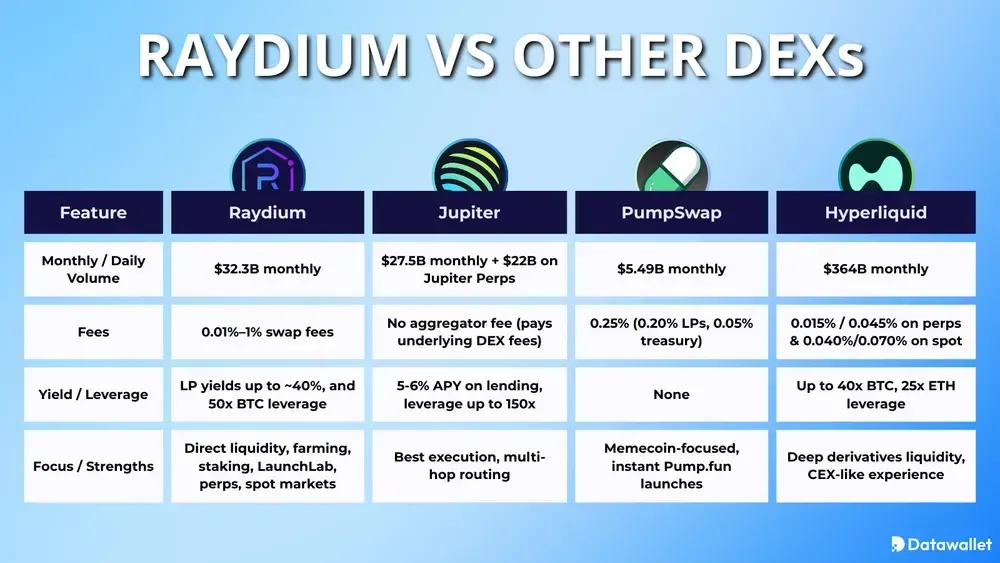
Raydium vs. Jupiter
Compared to Jupiter, which processes $30-50B in monthly volume with no aggregator fee, Raydium generates $32.3B, and offers swap fees from 0.01%-1%, LP yields up to ~40%. Jupiter excels at finding best execution prices, while Raydium provides direct liquidity markets and earning opportunities.
Raydium vs. PumpSwap
Against PumpSwap’s memecoin-only focus and peak $400-460M daily volume with a 0.25% fee (0.20% LPs), Raydium’s LaunchLab charges 1%, supports major tokens, and offers incentivized farming. PumpSwap is built for immediate meme launches, whereas Raydium balances niche and mainstream markets.
Raydium vs. Hyperliquid
Versus Hyperliquid’s 40x BTC and 25x ETH leverage, 0.015%-0.045% fees, and $364 billion in monthly derivatives volume, Raydium offers 50x BTC leverage but integrates perps with spot trading, liquidity pools, and launchpads. Hyperliquid is pure derivatives depth; Raydium is an all-in-one Solana DeFi platform.
Final Thoughts
Is Raydium the right DEX for you? In our view, Raydium offers one of the most all-round DeFi getaways on Solana, beating direct competitors like Orca and Drift, and in some categories even Jupiter.
Over the past few years, we’ve watched it grow from a novel AMM+order book experiment into a full-fledged platform with swapping, pro trading tools, yield farming, staking, and token launches.
It’s an ambitious project that largely delivers: beginners get an easy way to swap tokens with low fees, while power users get features like limit orders and lucrative farming opportunities.
Frequently asked questions
How do you stake RAY tokens on Raydium?
To stake RAY, connect your Solana wallet to Raydium, navigate to the “Staking” tab, and choose the amount to stake. Once confirmed, your tokens start earning rewards from a portion of the platform’s trading fees, with no impermanent loss risk.
Can you use Raydium without paying high gas fees?
Yes. Raydium runs on the Solana blockchain, where most transactions cost between 0.0001 and 0.001 SOL. Even complex actions like providing liquidity or staking typically cost less than a cent in network fees.
What is the difference between Raydium’s CLMM and standard AMM pools?
CLMM (Concentrated Liquidity Market Maker) pools let liquidity providers choose specific price ranges for more efficient capital use. Standard AMM pools spread liquidity across the entire price curve, offering simplicity but usually lower fee earnings per unit of capital.
Does Raydium support new token launches besides memecoins?
Yes. While LaunchLab focuses on memecoins and micro-cap tokens, Raydium’s AcceleRaytor launchpad supports more established projects, IDOs, and ecosystem growth initiatives. Both systems provide on-chain liquidity migration to Raydium pools after reaching fundraising thresholds.
.webp)
Written by
Jed Barker
Editor-in-Chief
Jed, a digital asset analyst since 2015, founded Datawallet to simplify crypto and decentralized finance. His background includes research roles in leading publications and a venture firm, reflecting his commitment to making complex financial concepts accessible.

.webp)
%2520(1).webp)






